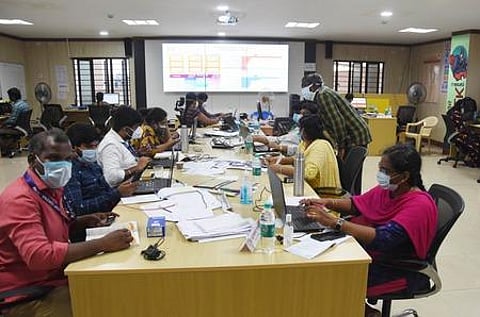

CHENNAI: Inside a hall on the seventh floor of a Chennai high-rise, a large television screen shows the live feed of hundreds of Covid-19 ambulances plying across Tamil Nadu on a satellite map. Two healthcare professionals, on headphones, observe clusters of ambulances waiting outside hospitals.
One of them, after spotting a cluster of 20 ambulances outside a hospital, clicks on an icon and the driver’s number pops up. The staff calls him and asks him to move to a lesser-crowded government hospital nearby. The driver accepts the advice, and moves out.
This a scene from the Covid-19 ‘war room’ established by the State government a few weeks ago. Started as a Unified Command Centre (UCC) on April 30 at the campus of Directorate of Public Health, the facility was soon upgraded to a war room by Chief Minister MK Stalin. At its helm, is Dr Darez Ahamed, former director of National Health Mission and an IAS officer.
Purpose in detail
According to Dr Adithyan GS, Nodal Officer, State Covid-19 war room, the facility was established to connect the various departments of health in Tamil Nadu to a central location to help streamline patient requests. “The war room filters emergency calls made to 104 helpline and primarily deals with requirements of oxygen beds and ICU beds,” he said.
The doctor pointed out that the 150-staff-strong war room gets an average 15,000 requests from across the State daily. The staff, include training specialists and paramedics, work in three eight-hour shifts, doing works such as monitoring social media requests, call requests, and triaging.
Role of social media
The State government had opened an official handle for 104 helpline on Twitter, and patients send requests for assistance by tagging the handle or by direct messaging. Roubitha David, a public-health consultant heading Social Media Surveillance Cell at the war room, said the role of staff at the social-media team has been evolving since they took charge.
“After the new @104_GoTN Twitter handle came up, we introduced Google forms for patients and #BedsForTN hashtag to streamline data better,” Roubitha said. She said the social-media team does not filter a message at the point of collection and they respond to all requests.
Triaging patients
The next work at the war room after filtering is triaging patients and ensuring that they get the right kind of treatment. Dr Sharanya Shankar, triaging doctor at the war room, said basic details of patients are filled by call-centre staff.
From the war room, they call patients to check on their health and SPO2 levels. “We ask patients details of the oxygen support they are getting, CT score, and RT-PCR report. With these details, we triage them on whether they need home isolation or hospitalization,” said Dr Sharanya.
She said triaging is done, details are forwarded to a bed-allocation team, who will work on arranging for beds for the patients. She added that an average 30 to 40 percent of those calling the war room require oxygen support.
WATCH:
Coordination and control
The war room has a large display showing live bed status from hospitals across the State and gets updated every hour. The display also has pie-charts showing number of oxygen beds, ICU beds, and ventilator beds. These points are updated throughout the day. “We have three teams for streamlining bed requests: One manages medical-college hospitals, another, private hospitals, and the third, second-tier hospitals,” said Dr Adithyan.
Dr SR Ganesh, Health Officer & Nodal person for 104 and 108 ambulance coordination, said they monitor ambulances 24/7. “Whenever we see a cluster of ambulances, we call the driver and suggest alternative healthcare facilities to break the cluster,” says Dr Ganesh.
The ambulances are shown as small icons on a map and when the staff presses the icon, details such as ambulance number, vehicle moving speed, driver’s contact number, and name of district pops up. “Experts sometimes triage patients in the ambulance itself. A total of 1,276 GPS devices are now connected to ambulances for real-time monitoring,” Dr Ganesh told Express.
A major challenge
A huge challenge the war room faces is duplication of oxygen beds and ICU requests made by patients and their kin. Dr Viduthalai Virumbi, Health, and IT Nodal officer, State war room, said the doctors have very little time to filter requests and allocate beds for Covid-19 patients.
“In this short time, when we get multiple requests for the same patient from different people, too much time is wasted filtering that request. So, we request family members of patients not to make multiple requests for the same patient,” he said. Officials said that they are coming up with a cutting-edge software to filter out duplication of requests.
Dr Viduthalai said that the war room has now been decentralized to all districts in the State and that this helps to triage patients at district-level itself. “People can use the district war rooms efficiently. They can also fill their own forms and get the reference ID themselves,” he adds.